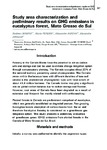Please use this identifier to cite or link to this item:
http://www.alice.cnptia.embrapa.br/alice/handle/doc/1060154| Title: | Study area characterization and preliminary results on GHG emissions in eucalyptus forest, Mato Grosso do Sul. |
| Authors: | MAURO, R.  PEREIRA, M.   AGIOVA, A.   ARAUJO, A.   |
| Affiliation: | RODINEY DE ARRUDA MAURO, CNPGC; MARTA PEREIRA DA SILVA, CNPGC; JOSE ALEXANDRE AGIOVA DA COSTA, CNPC; ALEXANDRE ROMEIRO DE ARAUJO, CNPGC. |
| Date Issued: | 2016 |
| Citation: | In: SIMPÓSIO INTERNACIONAL SOBRE GASES DE EFEITO ESTUFA NA AGROPECUÁRIA, 2. 2016, Campo Grande, MS. Anais... Campo Grande: Embrapa Gado de Corte, 2016. (Gado de Corte. Documentos, 216). |
| Pages: | p. 97-99 |
| Description: | Forestry in the Cerrado Biome have the potential to act as carbon sink and storage and can be used as climate change mitigation option through compensatory planting. The Cerrado occupies about 23% of the national territory, presenting varied physiognomies. The Cerrado sensu stricto (herbaceous layer with different densities of tree and shrubs) is the predominant physiognomic type with total extent of about 41.8 million hectares. The Cerrado biome may play a significant role on global carbon balance due to carbon storage and fixation. However, vast areas of Cerrado have been degraded as a result of extensive and frequent fire mainly related with cattle ranching. Planted forests in Cerrado are predominant comprised of eucalyptus, which are generally established on degraded pasture. Fast growing Eucalyptus boosts absorption of carbon dioxide from the air and therefore Eucalyptus forestry is considered as a greenhouse gas mitigation option. This study presents a preliminary evaluation of greenhouse gases (GHG) emissions from planted forests in the Cerrado of Mato Grosso do Sul, Brazil. |
| Thesagro: | Carbono Cerrado |
| NAL Thesaurus: | Carbon sinks Carbon markets |
| Keywords: | Cerrado biome |
| Type of Material: | Artigo em anais e proceedings |
| Access: | openAccess |
| Appears in Collections: | Artigo em anais de congresso (CNPGC)  |
Files in This Item:
| File | Description | Size | Format | |
|---|---|---|---|---|
| Studyareacharacterization.pdf | 622,83 kB | Adobe PDF |  View/Open |









